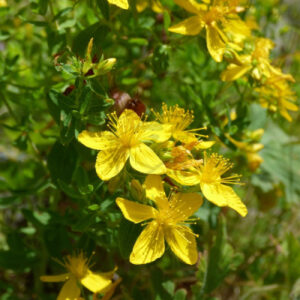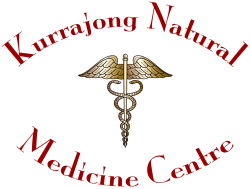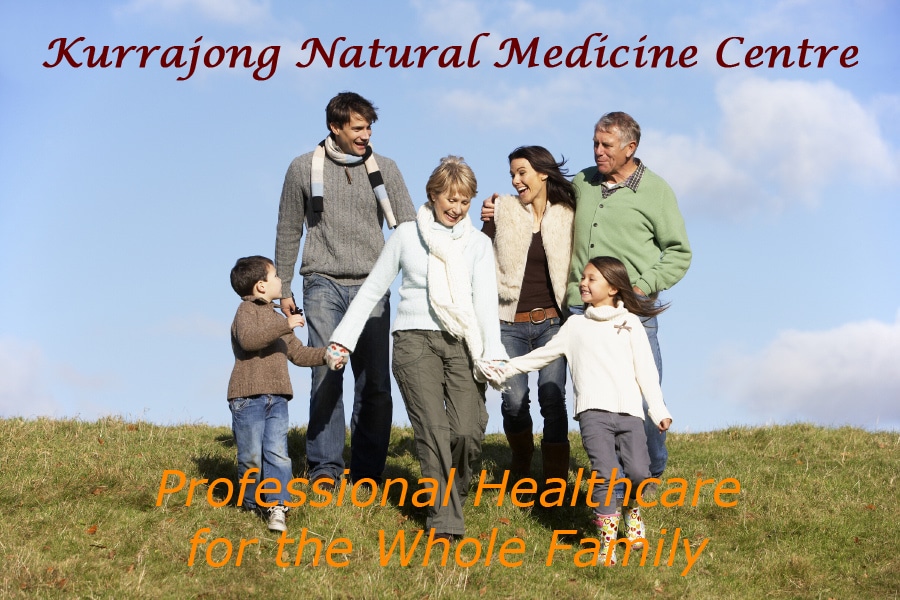Medicinal Herb: St. John's Wort (Hypericum perforatum)
St. John’s Wort
Biological Name:
(Hypericum perforatum L.)
Family:
Hypericaceae
Other Names:
Johnswort, Amber, Touch-and-heal, Goat weed, Hardhay, Klamath Weed, Rosin Rose, Hypericum, Tipton weed.

Introduction:
St. John’s Wort is an erect perennial herb that grows up to 32 inches tall and has a somewhat woody base. Commonly found in dry, gravelly soils, fields and sunny places in many parts of the world, including eastern North America and the Pacific coast.
A woody branched root produces many round stems which put out runners from the base. The opposite, oblong to linear leaves are covered with transparent oil glands that look like holes. Flat topped cymes of yellow flowers, whose petals are dotted with black along the margins, appear from June to September. The fruit is a three celled capsule containing small, dark brown seeds. The whole plant has turpentine-like odor.
Active Compounds:
Hypericin and pseudohypericin are believed to have antidepressive and
antiviral properties. Other constituents, include:
- naphthodianthrones (hypericin and pseudohypericin),
- prenylated acylphloroglucinols (hyperforin and adhyperforin),
- flavonoids (quercetin, hyperoside, rutin, catechin and isoquercitrin),
- biflavones (amentoflavone, biapigenin),
- phenolic compounds (chlorogenic acid, tannic acid and caffeic acid),
- xanthones (1,3,6,7‐tetrahydroxyxanthone) and
- essential oil rich in sesquiterpenes
Uses based on scientific evidence:
St John’s wort is an important herb that has been used in the treatment of various ailments for Millenia. Many studies have shown that extracts from Hypericum possess a wide array of pharmacological properties including antidepressant, anti‐inflammatory, antiviral, anticancer and antibacterial activities. Specifically, it has been shown that extracts of Hypericum are as efficient as their pharmaceutical counterparts such as fluoxetine (Prozac), sertraline (Zoloft) and other leading antidepressant drugs in the treatment of depression.[1] In addition, recent studies have shown promising effects for the treatment of obesity,[2] and Post-Menopausal syndrome.[3]
Traditional Uses in Herbal Medicine:
- Depression
- Anxiety
- Fatigue
- Insomnia
- Pain – specifically nerve pain
- Premenstrual syndrome
- Post-Menopausal syndrome
- Wound healing
- Inflammation of the skin
In Herbal Medicine, St. John’s Wort is used as an Antispasmodic, astringent, expectorant, nervine, vulnerary, anti-inflammatory, anti-microbial. Used in all pulmonary complaints, bladder disorders, in suppression of urine, dysentery, worms, diarrhoea, hysteria and nervous depression, haemoptysis and other haemorrhages and jaundice.[4]
For children troubled with incontinence of urine at night an infusion or tea given before retiring will be found effectual. It is also useful in TB, chronic catarrh of the lungs, bowels or urinary passages. Apply externally for softening of hard tumours, caked breasts, ecchymosis, etc.
Hypericum was recommended by Hippocrates for “nervous unrest.” It has a 2400-year history of folk use for anxiety; sleep disturbances, and worry. Modern medical research has shown that Hypericum can be as effective as prescription antidepressants for mild to moderate depression. However, unlike prescription antidepressants, Hypericum’s side effects are few and mild.
The standardised extract of St. John’s Wort (containing 0.14 percent hypericin) has significant support in the treatment of mild to moderate depression. The official German Commission E monograph for St. John’s Wort lists psychovegetative disturbances, depressive states, fear, and nervous disturbances as clinical indications for the extract.
Clinical studies have shown significant improvement in symptoms of anxiety, apathy, hypersomnia, and insomnia, anorexia, psychomotor retardation, depression feelings of worthlessness. Clinical double blind studies indicated that St. John’s Wort extract (0.3% hypericin) at a dosage of 300 milligrams three times daily is as effective in relieving symptoms of depression as standard antidepressants but is much better tolerated with fewer side effects than pharmaceutical medication.
Hypericum is now the number one antidepressant, natural or synthetic, prescribed by German physicians. In Germany, Hypericum accounts for over 50 percent of the antidepressant market, while Prozac is down to 2 percent.
In addition to Hypericum’s mood-elevating properties, Germany’s Commission E has approved this herb for the treatment of anxiety and sleep disorders. In two clinical studies, Hypericum demonstrated anti-anxiety effects comparable to those of Valium (diazepam). Yet Hypericum is not addictive and does not impair cognitive functions.
Taken internally, St. Johns Wort has a sedative and pain reducing effect, which gives it a place in the treatment of neuralgia, anxiety, tension and similar problems. It is especially regarded as a herb to use where there are menopausal changes triggering irritability and anxiety. In addition to neuralgic pain, it will ease fibrositis, sciatica and rheumatic pain.
Externally it is a valuable healing and anti-inflammatory remedy. As a lotion it will speed the healing of wounds and bruises, varicose veins and mild burns. The oil is especially useful for the healing of sunburn.
The calming properties of St. John’s Wort have been useful in treating bedwetting, insomnia, and other nervous conditions, as well as some form of melancholy. An oil extract of the herb can be taken for stomach ache, colic, intestinal problems, and as an expectorant for the congestion in the lungs. A tea made from the flowers is good for anemia, headache, insomnia, jaundice, chest congestion, and catarrh. A tea made from the herb has been used for uterine cramping and menstrual difficulties. The oil extract also make a good external application for burns, wounds, sores, bruises, and other skin problems.
St. John’s Wort is also being tested as an AIDS drug. There is evidence of its antiviral actions. Anecdotal reports have claimed hypericin is beneficial for persons with HIV virus. There are also reports that hypericin extract works synergistically with AZT against HIV. Further clinical research is in progress in this area.
Safety:
Hypericum/St. John’s Wort should only be taken on advice/prescription of a qualified healthcare professional, as it does have potentially harmful side-effects.
Hypericum should not be combined with a Monoamine oxidase (MAO) inhibitor antidepressant such as Nardil (phenelzine) or Parnate (tranylcypromine). This combination can produce a dangerous rise in blood pressure or hypertensive crisis, along with severe anxiety, fever, muscle tension, and confusion. After stopping a MAO inhibitor, one should wait at least four weeks before taking other antidepressants, including Hypericum.
There are some recent reports that suggest that St. John’s Wort may interfere with medications given during organ transplant (such as kidney and liver.) Do not take this herb if you have undergone or plan to undergo a transplant operation.
Avoid foods and medications that are known to interact negatively with MAO-inhibiting drugs. Tyramine containing foods ( red wine, cheese, beer, yeast, and pickled herring) and drugs such as L-dopa and 5-hydoxytryptophan should be avoided. St. John’s Wort should not be used at the same time as prescription antidepressants. Do not use St. John’s Wort during pregnancy or lactation.
St. John’s Wort makes the skin more light sensitive. Persons with fair skin should avoid exposure to strong sunlight and other sources of ultraviolet light, such as tanning beds. These individuals may suffer a dermatitis, severe burning, and possibly blistering of the skin. The severity of these effects will depend on the amount of the plant consumed and the length of exposure to sunlight. Some experts suggest that all individuals avoid sunlight when using hypericin, especially when taking large quantities.
Saint John’s Wort has a good safety record over centuries of folk medicine. In contrast to synthetic antidepressants, there have been no reports of Hypericum-related deaths. Drug monitoring studies on over 7000 patients and twenty-seven double-blind research studies confirm its safety. The extensive use of Hypericum by millions of people has not resulted in reports of serious side effects.
Cultivation
Climate and Soil:
- It thrives in temperate climates and is adaptable to a variety of soil types, although it prefers well-drained, sandy soils.
- It can grow in both sunny and partially shaded areas.
Planting:
- Seeds can be sown in autumn or spring.
- It also propagates well through root division or cuttings.
- Ensure good spacing (about 1 to 2 feet apart) as the plant can spread considerably.
Watering and Feeding:
- Regular watering is necessary, especially in dry periods, but avoid waterlogging.
- Fertilization isn’t usually required, as the plant can thrive in poor soil conditions.
Pruning and Harvesting:
- Pruning is done to encourage bushier growth.
- Flowers are typically harvested when they are in full bloom, usually in mid-summer.
- The aerial parts (flowers, leaves, and stems) are used for medicinal purposes.
Pest and Disease Control:
- Generally, it has few problems with pests and diseases.
- Overly moist conditions can lead to root rot or fungal infections.
Ecology
Native Habitat:
- Originally native to Europe, but now widely naturalized in North America, parts of Asia, and Australia.
- Commonly found in meadows, roadsides, and forest edges.
Impact on Local Ecosystems:
- In some regions, particularly in North America and Australia, it is considered an invasive species because it competes with native plants.
- Produces allelopathic chemicals that can inhibit the growth of surrounding vegetation.
Interactions with Wildlife:
- It’s visited by various pollinators, including bees and butterflies.
- Some studies suggest it can be toxic to grazing animals, especially when consumed in large quantities.
Conservation Status:
- Not considered endangered or threatened. In fact, its ability to spread aggressively has made it a target for control in some regions.
References
- Shakya, P., Marslin, G., Siram, K., Beerhues, L., & Franklin, G. (2019). Elicitation as a tool to improve the profiles of high-value secondary metabolites and pharmacological properties of Hypericum perforatum. The Journal of pharmacy and pharmacology, 71(1), 70–82. https://doi.org/10.1111/jphp.12743
- Tokgöz HB, Altan F. Hypericum perforatum L.: a medicinal plant with potential as a curative agent against obesity-associated complications. Mol Biol Rep. 2020 Nov;47(11):8679-8686. doi: 10.1007/s11033-020-05912-7. Epub 2020 Oct 22. PMID: 33090307.
- Eatemadnia A, Ansari S, Abedi P, Najar S. The effect of Hypericum perforatum on postmenopausal symptoms and depression: A randomized controlled trial. Complement Ther Med. 2019 Aug;45:109-113. doi: 10.1016/j.ctim.2019.05.028. Epub 2019 May 31. PMID: 31331546.
- https://www.botanical.com/botanical/mgmh/s/sajohn06.html
Disclaimer
Disclaimer information for users of the Kurrajong Natural Medicine Centre, Namaste Yoga Kurrajong and The Herbal Health Coach website.
Page last updated: 26th June 2020
Information provided for education and research information only
The information on this website is presented by Kurrajong Natural Medicine Centre for the purpose of disseminating health information free of charge for the benefit of the public.
While Kurrajong Natural Medicine Centre has exercised due care in ensuring the accuracy of the material contained on this website, the information on the site is made available on the basis that Kurrajong Natural Medicine Centre is not providing professional advice on a particular matter.
This website is not a substitute for independent professional advice. Nothing contained in this site is intended to be used as medical advice and it is not intended to be used to diagnose, treat, cure or prevent any disease, nor should it be used for therapeutic purposes or as a substitute for your own health professional’s advice.
Kurrajong Natural Medicine Centre does not accept any liability for any injury, loss or damage incurred by use of or reliance on the information provided on this website.
Quality of information
Kurrajong Natural Medicine Centre makes every effort to ensure the quality of the information available on this website and updates the information regularly. Before relying on the information on this site, however, users should carefully evaluate its accuracy, currency, completeness and relevance for their purposes, and should obtain any appropriate professional advice relevant to their particular circumstances. Kurrajong Natural Medicine Centre cannot guarantee and assumes no legal liability or responsibility for the accuracy, currency, completeness or interpretation of the information.
The material may include the views or recommendations of third parties and does not necessarily reflect the views of Kurrajong Natural Medicine Centre or indicate a commitment to a particular course of action.
Links to other websites
This website contains links to other websites which are external to Kurrajong Natural Medicine Centre. Kurrajong Natural Medicine Centre takes reasonable care in selecting linking websites but Kurrajong Natural Medicine Centre accepts no responsibility for material contained in a website that is linked to this site. It is the responsibility of the user to make their own decisions about the accuracy, currency, reliability and correctness of information contained in linked external websites.
Links to external websites are provided for the user’s convenience and do not constitute an endorsement or a recommendation of any third party products or services offered by virtue of any information, material or content linked from or to this site. Users of links provided by this site are responsible for being aware of which organisation is hosting the site they visit.
Views or recommendations provided in linked sites may include the views or recommendations of third parties and do not necessarily reflect those of Kurrajong Natural Medicine Centre or indicate a commitment to a particular course of action. .



